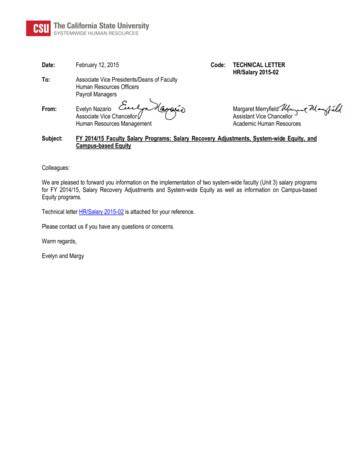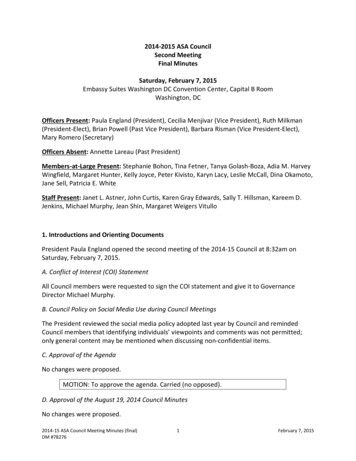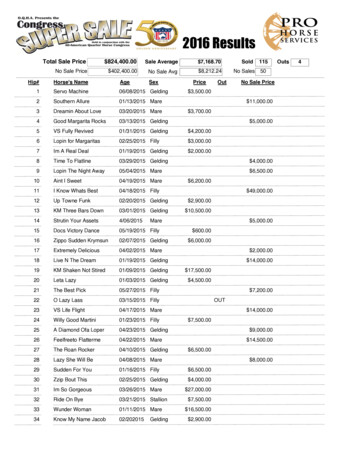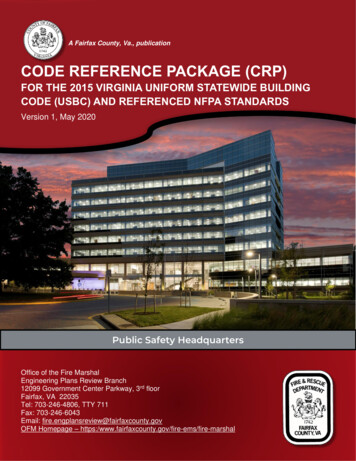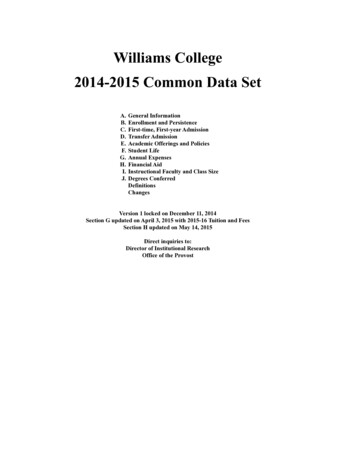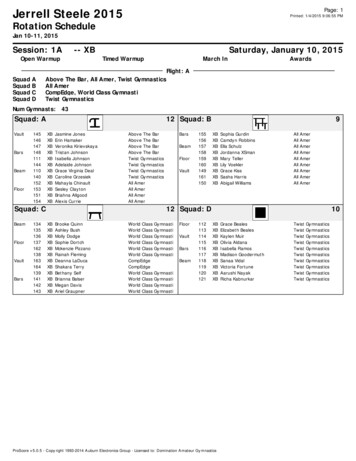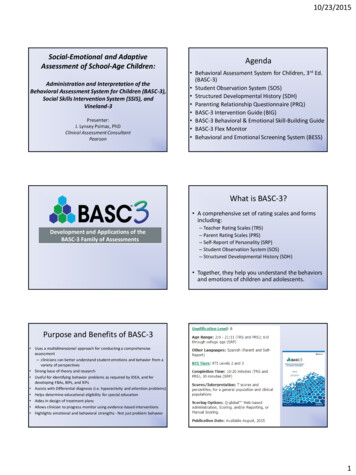
Transcription
10/23/2015Social-Emotional and AdaptiveAssessment of School-Age Children:Administration and Interpretation of theBehavioral Assessment System for Children (BASC-3),Social Skills Intervention System (SSIS), andVineland-3Presenter:J. Lynsey Psimas, PhDClinical Assessment ConsultantPearsonAgenda Behavioral Assessment System for Children, 3rd Ed.(BASC-3) Student Observation System (SOS) Structured Developmental History (SDH) Parenting Relationship Questionnaire (PRQ) BASC-3 Intervention Guide (BIG) BASC-3 Behavioral & Emotional Skill-Building Guide BASC-3 Flex Monitor Behavioral and Emotional Screening System (BESS)What is BASC-3? A comprehensive set of rating scales and formsincluding:Development and Applications of theBASC-3 Family of Assessments– Teacher Rating Scales (TRS)– Parent Rating Scales (PRS)– Self-Report of Personality (SRP)– Student Observation System (SOS)– Structured Developmental History (SDH) Together, they help you understand the behaviorsand emotions of children and adolescents.Purpose and Benefits of BASC-3 Uses a multidimensional approach for conducting a comprehensiveassessment– clinicians can better understand student emotions and behavior from avariety of perspectives Strong base of theory and research Useful for identifying behavior problems as required by IDEA, and fordeveloping FBAs, BIPs, and IEPs Assists with Differential diagnosis (i.e. hyperactivity and attention problems) Helps determine educational eligibility for special education Aides in design of treatment plans Allows clinician to progress monitor using evidence-based interventions Highlights emotional and behavioral strengths - Not just problem behavior1
10/23/2015BASC-3 Revision GoalsAuthors of BASC-3Randy W. Kamphaus, Ph.D.Cecil R. Reynolds, Ph.D. Maintain measurement integrity and quality Improve integration of components Improve item content, scale reliability, and score inferencevalidity Offer new content scales without lengthening the ratingscales significantly Enhance flexibility of administration and reporting options Enhance progress monitoring Enhance links and implementation to verified interventionstrategiesWhat is the BASC-3?Multi-Dimensional SystemA Multidimensional, Multimethod approach to assessingchild and adolescent Emotional Disabilities . Multidimensional - Measures differentaspects of behavior and personalityIncludes: Positive, adaptive dimensions such asleadership, social skills, and study skills. Negative, clinical dimensions such asaggression, anxiety, and depression.Comprehensive Diagnostics &Behavior ManagementMulti-Method SystemTRS: Teacher Rating ScalesPRS: Parent Rating ScalesSRP: Self-Report of PersonalitySRP-I: Self-Report of PersonalityInterview (ages 6-7)PRQ: Parenting Relationship QuestionnaireSDH: Structured Developmental HistorySOS: Student Observation SystemSCREEN Behavior &EmotionalScreeningSystem (BESS)ASSESS/DIAGNOSE Teacher RatingScales (TRS),Parent RatingScales (PRS), SelfReport ofPersonality (SRP) ParentingRelationshipQuestionnaire(PRQ) StructuredDevelopmentalHistory (SDH)INTERVENE BehaviorIntervention GuideMONITOR FLEX Monitor Fixed monitor Behavioral andEmotional SkillBuilding Guides—classroom andpsychologistversions Parent tip sheets StudentObservationSystem (SOS) TreatmentFidelityDocumentation Evidence-basedinterventionsmatched toexaminee profiles StudentObservationSystem (SOS)2
10/23/2015BASC-3 Diagnostic Components SDH: The Structured-Developmental HistoryAll ages SOS: Student Observation SystemAll ages SRP: Self-report of PersonalitySRP-ISRP-CAges 6-7Ages 8-11SRP-AAges 12-21 PRS: Parent Rating ScalesPRS-PPRS-CAges 2-5Ages 6-11PRS-AAges 12-21 TRS: Teacher Rating ScalesTRS-PTRS-CAges 2-5Ages 6-11TRS-AAges 12-21 SRP-COLAges 18-25PRQ: Parenting Relationship QuestionnaireAges 2-18The American Academy of Pediatrics (AAP)Report on Diagnosis of ADHD In 2000, the American Academy of Pediatrics (AAP)noted that ADHD is a common problem and becomingincreasingly a controversial one The AAP recommended broad diagnostic work that islargely behaviorally-based.(AAP Committee on Quality Improvement, 2000)All Are Available via Paper and Q-Global/DigitalAll Forms (Except TRS) are Available in English and SpanishThe American Academy of Pediatricsrecommended that The assessment of ADHD should include:– information obtained directly from parents/caregivers, as wellas a classroom teacher or other school professional, regardingthe core symptoms of ADHD in various settings, the age ofonset, duration of symptoms and degree of functionalimpairment.These recommendations apply not just toDSM diagnoses The criteria for classification of a student asEmotionally Disturbed under IDEIA requires thatwe look broadly at children, the context of theirbehavior, history, and acuteness/chronicity. Evaluation of a child with ADHD should also include assessmentfor co-existing conditions: learning and language problems,aggression, disruptive behavior, depression or anxiety. As many as one-third of children diagnosed with ADHD also havea co-existing condition.IDEIA’s Definition of Emotional Disturbance The term means a condition exhibiting one or more of the followingcharacteristics over a long period of time and to a marked degree thatadversely affects a child’s educational performance:– An inability to learn that cannot be explained by intellectual, sensory, orhealth factors;– An inability to build or maintain satisfactory interpersonal relationshipswith peers and teachers;– Inappropriate types of behavior or feelings under normal circumstances;– A general pervasive mood of unhappiness or depression;– A tendency to develop physical symptoms or fears associated withpersonal or school problems; The term includes schizophrenia. The term does not apply to children whoare socially maladjusted, unless it is determined that they have anemotional disturbance.ISBE’s Definition of Emotional Disability Emotional Disability (includes schizophrenia but does not apply tochildren who are socially maladjusted, unless it is determined that theyhave an emotional disturbance) means a condition exhibiting one ormore of the following characteristics over a long period of time and to amarked degree that adversely affects a child's educational performance:– An inability to learn that cannot be explained by intellectual, sensory, orhealth factors;– An inability to build or maintain satisfactory interpersonal relationships withpeers and teachers;– Inappropriate types of behavior or feelings under normal circumstances;– A general pervasive mood of unhappiness or depression; or– A tendency to develop physical symptoms or fears associated with personalor school problems.3
10/23/2015Social MaladjustmentKnow who you are evaluating:“Symptoms” do not mean the same thing for everyone. “ there is a final, perhaps fatal flaw in thispractice. The “Achilles heel” in this regard maybe the problem of co-occurrence orcomorbidity ” (p. 903) Comorbidities are common in childhoodpsychopathology and being sociallymaladjusted does not make one immune fromED’s.Merrell, K.W., & Walker, H.M. (2004). Deconstructing a definition: Socialmaladjustment versus emotional disturbance and moving the EBD field forward.Psychology in the Schools, 41, 899-910.Poor Academic Outcomes Associatedwith Presence of an ED Lower grades and poor attendance rates(Suldo, Thalji, & Ferron, 2011) Greater incidence of adolescent smoking (Lewis et al., 2011), illicitsubstance use (Goodman, 2010), and alcohol. More mental health disorders in early adulthood(Johnson, Cohen, & Kasen, 2009; Kinnunen, Laukkanen, &Kylma, 2009). Only 20% of students in special education with emotional andbehavioral disorders pursue any type of post-secondaryeducation(Wagner, Kutash, Duchnowski, & Epstein, 2005).DEVELOPMENT & STANDARDIZATIONBASC-3 Standardization Sites MapDevelopment of the BASC–3 Items were selected based on:– Standardized item loading in SEM analyses (English & Spanish)– Item-total correlation– Item bias statistics– Construct relevance– Clinical groups discrimination General normative sample was be stratified by:– Gender by race/ethnicity– Gender by geographic region– Gender by parent education level234
10/23/2015Development of PRS & SRP Spanish Forms Firm experienced in translating psychological testscompleted initial translation of all existing items. New items evaluated and back-translated by in-house staff. Bilingual psychologists from across US reviewed thematerials. Additional rounds of changes were conducted to come upwith standardization item sets. Psychometric properties of Spanish items were evaluatedprior to making final item selections.TRS & PRS – What’s New?Teacher Rating Scales (TRS)andParent Rating Scales (PRS)TRS, PRS, and SRP – What’s New? On average, across the TRS and PRS forms there are 32%new items. Significant addition to Developmental Social Disorder items. Significant addition to Executive Functioning items– Based on research by Dr. Mauricio A. Garcia- Barrera ofthe University of Victoria, BC, Canada.– 4 new EF subscales: Problem Solving, AttentionalControl, Behavioral Control, and Emotional ControlBASC-3 Scale TypesScale TypeDescriptionClinicalMeasures maladaptive behaviors, where high scores indicateproblematic levels of functioning.AdaptiveMeasures adaptive behaviors or behavioral strengths, where lowscores indicate possible problem areas.ContentMeasures maladaptive or adaptive behaviors. Some unique items,some clinical and adaptive items.CompositeComprised of scale groupings that are based on theory and factoranalytic results.ProbabilityIndexes(NEW)Empirically derived scales comprised of items from other scalesthat were selected based on their ability to differentiate thosewith and without behavioral or emotional functioning diagnosis aptiveScores5
ilityIndexesTRS/PRS Clinical ScalesClinical ScaleDescriptionAggressionThe tendency to act in a hostile manner (either verbal or physical)that is threatening to othersAnxietyAttention ProblemsThe tendency to be nervous, fearful, or worriedThe tendency to be easily distracted and unable to concentratemore than momentarilyThe tendency to behave in ways that are considered “odd” orcommonly associated with psychosisThe tendency to engage in antisocial and rule-breaking behavior,including destroying propertyFeelings of unhappiness, sadness, and stress that may result in aninability to carry out everyday activities or may bring on thoughts ofsuicideThe tendency to be overly active, rush through work or activities,and act without thinkingThe presence of academic difficulties, particularly understanding orcompleting homeworkThe tendency to be overly sensitive to and complain about relativelyminor physical problems and discomfortsAtypicalityConduct ProblemsDepressionHyperactivityLearning ProblemsSomatizationWithdrawalTRS/PRS Composite ptive SkillsBehavioralSymptoms IndexAdaptabilitySocial SkillsFunctional yAggressionDepressionAttention vitySocial SkillsAggressionFunctional Comm.DepressionLeadershipAttention ProblemsStudy tySocial SkillsAggressionFunctional Comm.DepressionActivities of Daily Living Attention vitySocial SkillsAggressionFunctional Comm.DepressionLeadershipAttention ProblemsActivities of Daily Living AtypicalityWithdrawalBASC–3 TRS & PRS Sample Clinical Scale ItemsAnxietyIs fearfulHas trouble making decisions HyperactivityActs without thinkingIs in constant motion AggressionBullies othersManipulates others Conduct ProblemsDisobeysHurts others on purpose DepressionIs negative about thingsSays, “I can’t do anything right”SomatizationIs afraid of getting sickComplains of physical problemsThe tendency to evade others to avoid social contactAdaptive ScalesTRS and PRS Sample Clinical Scale ItemsAdaptive Scale Attention ProblemsHas short attention spanHas trouble concentrating Learning ProblemsGets failing school gradesDemonstrates critical thinking skills AtypicalitySeems out of touch with realityActs as if other children are not thereWithdrawalIs fearfulHas trouble making decisions SchoolProblemsActivities of Daily LivingDescriptionSkills associated with performing basic, everydaytasks in an acceptable and safe mannerAdaptabilityThe ability to adapt readily to changes in theenvironmentFunctional CommunicationThe ability to express ideas and communicate in away others can easily understandLeadershipThe skills associated with accomplishing academic,social, or community goals, including the ability towork with othersSocial SkillsThe skills necessary for interacting successfully withpeers and adults in home, school, and communitysettingsStudy SkillsThe skills that are conducive to strong academicperformance, including organizational skills andgood study habits6
10/23/2015TRS/PRS Content ScalesContent ScaleAnger ControlDescriptionThe tendency to become irritated and/or angry quickly andimpulsively, coupled with an inability to regulate affect andself-controlThe tendency to be intrusive, cruel, threatening, or forcefulto get what is wanted through manipulation or coercionBullyingDevelopmental SocialDisordersEmotional Self-ControlThe tendency to display behaviors characterized by deficitsin social skills, communication, interests, and activities; suchbehaviors may include self-stimulation, withdrawal, andinappropriate socializationThe ability to regulate one’s affect and e
2 Authors of BASC-3 Randy W. Kamphaus, Ph.D. Cecil R. Reynolds, Ph.D. BASC-3 Revision Goals Maintain measurement integrity and quality Improve integration of components Improve item content, scale reliability, and score inference validity Offer new content scales without lengthening the rating scales significantly


